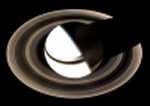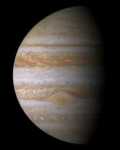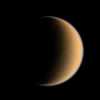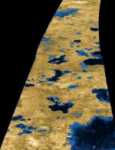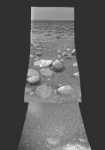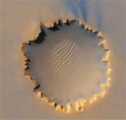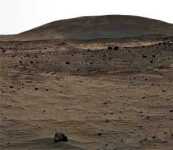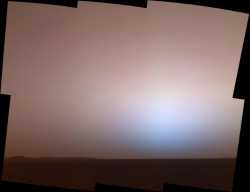When we were young, we looked up at the twinkling lights in the night sky and wondered. Most of them were immovable, fixed stars rising and setting in the same place every night as if pinned to the dome of the firmament. However, a very few of those lights were not so steady. Instead, they seemed to meander, moving perceptibly across the sky from night to night – sometimes even changing course and moving backwards for a time, as if in a spirit of play. We named these vagabond stars planets, after the Greek word planetes, which literally means “wanderer”.
For many long centuries, the nature of these wanderers was unknown to us. Our wise theologians advised us that they were no more than lights affixed to nested crystal spheres that rotated around us, placed as signs and portents so that we could marvel at the power of the cosmic Designer who framed them. Even the moon, closest to our own earth, was an orb of mystery whose ever-changing faces became synonymous with the unsettling and the strange.
But then we discovered how to grind glass to focus light, and distant rays streaming into our retinas brought illumination: the planets are not mere lights after all. They are places, whole worlds of their own, both like and unlike the Earth. They have mountains and valleys, craters and river channels, deserts and ice caps, and spectacular night skies of their own with rings, satellites, and one other wandering, blue star. It is true, our species has walked on the moon; we have taken our first tentative steps into that vast cosmic ocean that surrounds us. But there are other vistas that await us. Far from our humble yet beautiful world, there are other shores upon which no human being has ever set foot.
Yet where we have not traveled, our emissaries have gone before us: bright-eyed creatures with limbs of silver and gold, seeing into subtle bands of the spectrum we can only imagine. They hurtle unscathed through the vacuum of space, tireless through the long journey, until at last they reach their destination: an oasis appearing out of the void, a distant twinkle of light that swells into a vast new world. In obedience to the faint voices from their place of origin, our heralds swing into orbit around these distant shores, or descend to their surfaces. And there they have found magnificent beauty – landscapes of gorgeous desolation, of primordial power, of grand intricacy; landscapes that tell stories of an ancient history, a history that passed countless eons unregarded and unknown – until now. And what our messengers see, they report back to their makers.
At right is a magnificent image of Saturn, from high above the ringed planet’s north pole, taken on January 19 by the Cassini spacecraft now in orbit around that world. This is a natural-color view: if a human being was in this orbit, they would see the same image that Cassini saw. So fantastically perfect as to be almost unreal, Saturn sits half in sunlight and half in darkness, casting a vast shadow across the plane of its majestic rings. Stark and geometric in its clarity, the image makes it almost too easy to forget that this is not a mere model, but a vast world of its own, a gas giant larger than hundreds of Earths. Only Cassini’s celestial perspective, like a god looking down from on high – this picture was taken from a distance of three-quarters of a million miles – renders Saturn’s alien beauty as comprehensible as it is.
The Cassini mission has glimpsed other wonders as well. It took seven years of travel through the void for the probe to reach Saturn – a stark reminder of how enormous the distances are that separate us from even the nearest fellow worlds – but there were chances to survey other shores along the way.
At left is a true-color mosaic of the planet Jupiter, taken in December 2000. The gas giant is a world of clouds, banded with swirls of weather in intricate patterns of turbulence, wreathing and diffusing like smoke in air or colorful ink in a glass of milk. In the southern hemisphere, the vast cyclonic storm system called the Great Red Spot continues to roil and churn the atmosphere, as it has been doing since it was first observed by the astronomer Giovanni Cassini, in whose honor the current mission is named, in the 1600s.
When it comes to the truly cosmic, it is all but impossible for a limited human being to grasp the sense of scale. However, it may help to see how large the Earth is in comparison. In comparison to regal Jupiter, all the distant lands and mighty seas where Earth’s most famous explorers dared to venture are but a ripple in an unimaginably more enormous ocean of atmosphere. Though Jupiter has no solid surface on which to tread, a traveler who could soar through its upper reaches could spend a thousand human lifetimes and never see more than a tiny fraction of the stunning vistas that must surely await there.
But Jupiter and Saturn, for all their grandeur and their beauty, were not the Cassini probe’s only destinations. The ringed planet has a moon, named Titan – a world of unfathomable mystery, one that may even hold the keys to understanding the origin of life on our own blue planet.
Titan is the only moon in the solar system with a substantial atmosphere, one that is actually denser than Earth’s. But a dense orange haze clouds Titan’s atmosphere and hides its surface from view, and until recently we had no idea what lay beneath the clouds. There have been tantalizing hints. Based on spectroscopic observations and laboratory experiments similar to the famous Miller-Urey experiment, the late Carl Sagan concluded that Titan’s haze might be made of a muddy mixture of organic compounds called tholins – possible building blocks of life – that were constantly raining down on the moon’s surface like manna falling from heaven.
It has long been conjectured that lakes of liquid methane and ethane might exist on Titan’s frigid surface, and that these hydrocarbon lakes could be the source of the Titanian tholins. Evaporating and rising into the atmosphere, these simple compounds would be broken down by ultraviolet radiation from the Sun, recombining into the more complex organic molecules that shroud the surface in haze. But this idea is mere speculation no longer. Cassini’s radar can pierce the clouds of Titan, and several weeks ago, it returned this false-color image of dark, smooth patches of liquid on the moon’s rough surface – the long-hypothesized hydrocarbon lakes, glimpsed at last.
But we have done more than just examine Titan from orbit. The Cassini spacecraft carried a lander, Huygens, which parachuted down to the moon’s surface to report back on what it found. Here is one of the images it returned, a true example of an almost unimaginably distant shore:
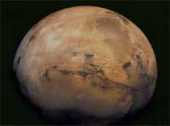
Above: An image of Mars taken by Viking 1. In the foreground, the vast Valles Marineris canyon system slices across the surface of the planet.
Not every shore we visit is as exotic as ringed Saturn or cloud-shrouded Titan. Our planetary neighbor Mars, compared to these strange and distant worlds, is practically a close friend, and we know it with familiarity befitting that designation. Both on the surface and from orbit, our robotic servants have mapped and explored Mars, peeling back the eons of its history, and uncovering stunning evidence of its past. Too small for its gravity to hold an atmosphere as dense as our own, Mars is now a dry, freezing desert, with an ethereally thin atmosphere and regular planet-wide dust storms. But we now know that it once had a warm, clement past complete with liquid running water, the prerequisite for all life as we know it. Astonishingly, Mars’ polar ice caps contain enough water to flood the entire planet to a depth of over thirty feet, and its surface bears signs of past reworking by water on a colossal scale. And though we have not yet found evidence of life on Mars, neither have we ruled out the possibility that it may still exist beneath the planet’s rusty soil.
Below is an image of the striking Martian surface feature known as Victoria Crater, the half-mile-wide scar of some ancient impact, taken from space by the Mars Reconnaissance Orbiter:
And here is an image of Victoria Crater’s rim from the surface, courtesy of the robotic rover Opportunity that is now exploring it:
Opportunity’s twin, Spirit, has not been slumbering either. Here is Spirit’s current view, the McMurdo Panorama, a landscape of desolation that nevertheless seems strikingly Earthlike:
Despite its loneliness, Mars can present scenes of astonishing beauty. On occasion, Spirit has even had the chance to pause from its scientific work and simply admire a sunset, so familiar and yet so strange, such as this one taken at Gusev Crater from April 2005:
Images like this are a much-needed reminder that the Earth is not the only place in the cosmos. Though the Earth is all we know, and sometimes this leads us to myopically imagine it is all there is, there is a whole universe of landscapes awaiting us. Our solar system alone contains a multitude of gorgeous and fantastic scenes which no human was ever privileged to see – until now.
In a very real sense, everyone alive today is an explorer on a scale more profound than the seafarers of bygone ages ever conceived of. Not with our bodies, but with our eyes and minds we have traveled forth to begin exploration of the cosmos. Images like this should teach us a valuable lesson in humility, a reminder that we are not the center of the universe. Yet at the same time, they should rightfully fill us with awe and wonder. There are wholly new worlds awaiting our study, places stranger and yet more beautiful than we could have imagined. How can such a revelation not fill us with joy?
All images in this post courtesy of NASA/JPL-Caltech. Original links: Saturn from Cassini; Jupiter from Cassini; Titan from Cassini; the lakes of Titan; Titan’s surface from Huygens; Mars from Viking 1; Victoria Crater from Mars Reconaissance Orbiter; Victoria Crater from Opportunity; McMurdo Panorama from Spirit; twilight at Gusev Crater from Spirit.
